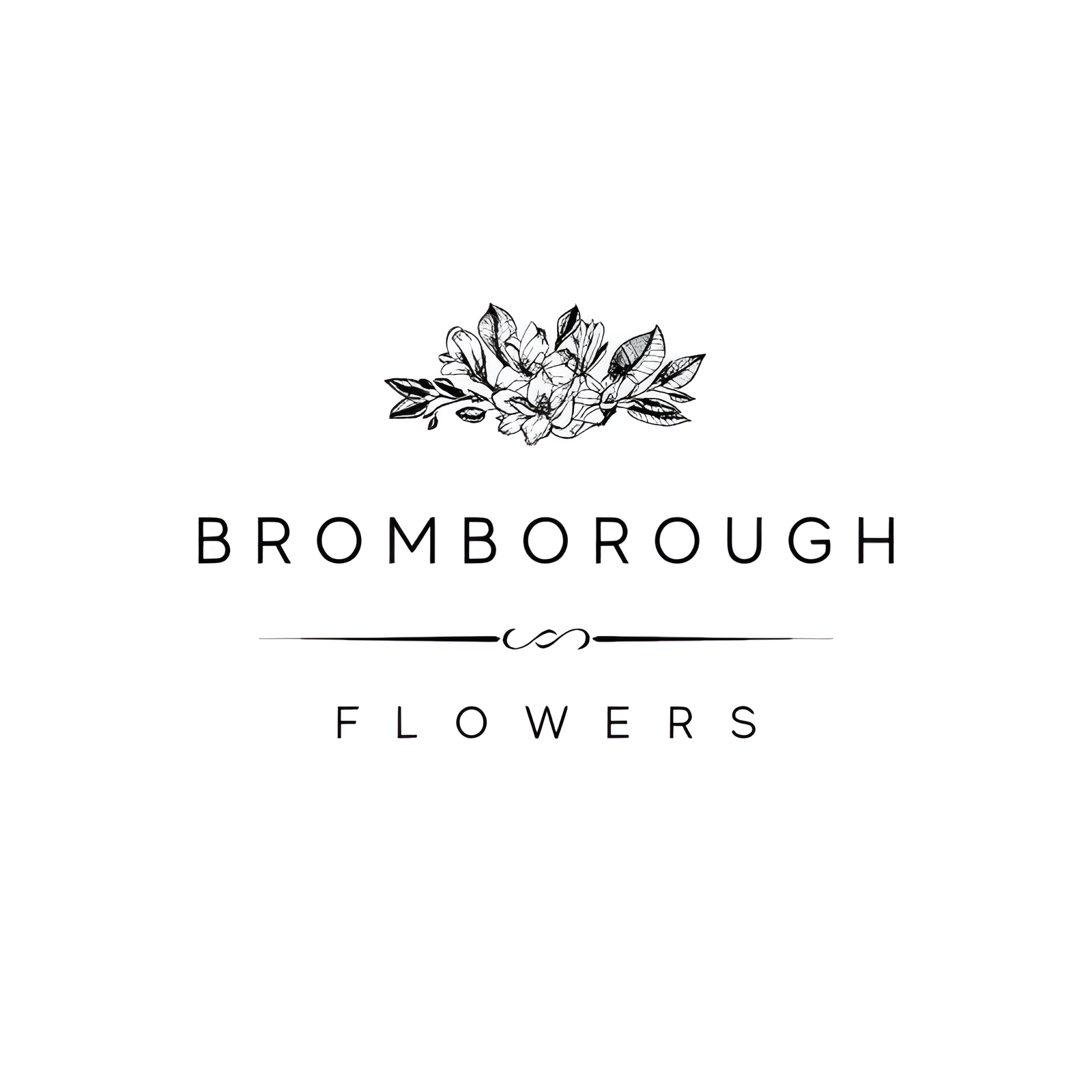In the domain of wedding florals, Eustoma, commonly known as Lisianthus, stands out for its understated grace and versatile application. Its bell-shaped blossoms and strong stems not only exude an aura of refinement but also convey deep meaning linked to concepts of peace, purity, and lasting love. Offered in a range of hues such as ivory, blush, and azure, Eustoma can be customized to harmonize with any wedding color scheme. As we delve into its distinctive characteristics, cultural importance, and practical applications, you'll uncover why this flower is a preferred option for many couples.
Flower Overview
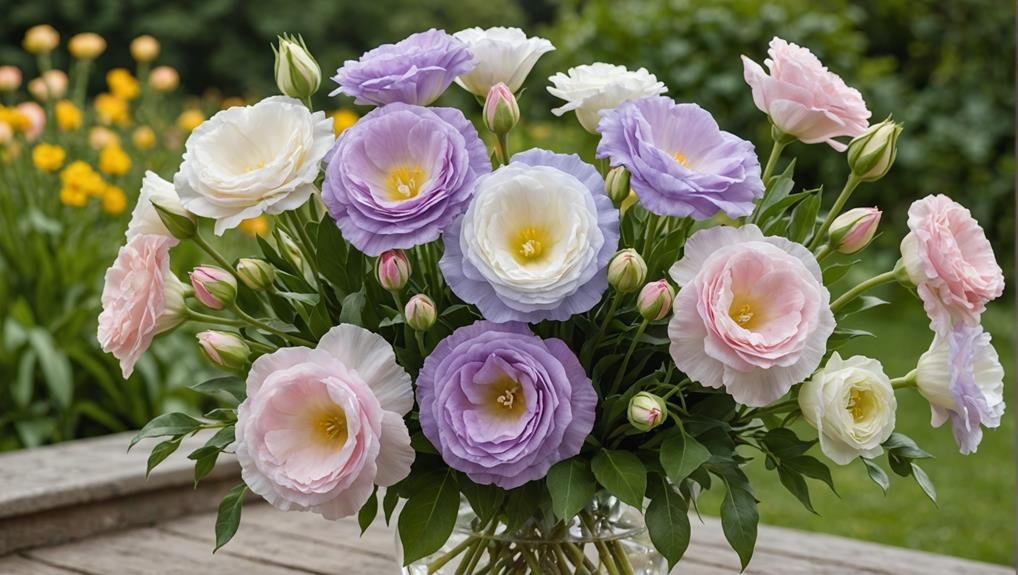
Eustoma, commonly known as Lisianthus, is a versatile flower celebrated for its delicate petals and wide color palette. Emblematic of peace, purity, admiration, and everlasting love, Lisianthus has become a favored choice for wedding flowers.
The pristine beauty of white lisianthus flowers, in particular, is ideal for bridal bouquets, centerpieces, and other floral decorations, adding an elegant touch to any ceremony.
For those planning DIY weddings, Lisianthus offers an excellent option due to its adaptability and ease of arrangement. Its ability to convey deep emotions makes it a fitting choice for both intimate gatherings and grand celebrations. The flower's varied hues, including shades of white, pink, purple, and blue, allow for versatile and personalized floral designs.
Proper flower care is essential to maintain the freshness and longevity of Lisianthus. This involves ensuring well-draining soil, full sun exposure, and consistent moisture. By adhering to these care guidelines, Eustoma can thrive and remain vibrant throughout the event.
Floristique provides a plethora of stunning Eustoma arrangements tailored for weddings, ensuring that each piece reflects the flower's timeless elegance and storytelling capabilities.
Physical Description
Characterized by their delicate petals forming bell-shaped heads, Lisianthus flowers exhibit a refined and elegant appearance that is highly valued in floral design. These flowers, also known as Eustoma or Texas Bluebell, belong to the Gentianaceae family and are celebrated for their graceful structure and visual appeal. The petals are often multilayered, creating a lush, full-bodied look that enhances any floral arrangement.
Lisianthus flowers are particularly notable for their long, sturdy stems, which make them an excellent choice for creating elegant wedding bouquets and centerpieces. The robust stems support the blossoms well, ensuring that they stand tall and maintain their beauty throughout the event. The leaves of the Lisianthus are typically lance-shaped and provide a subtle yet complementary backdrop to the blooms.
White blooms of Lisianthus are especially popular in wedding arrangements due to their symbolism of peace, purity, and everlasting love. These attributes make them a favored choice for couples seeking a timeless and sophisticated aesthetic for their special day. The combination of their physical attributes and symbolic meanings positions Lisianthus as a top choice for wedding flowers, emphasizing both elegance and sentimentality.
Available Colour Varieties
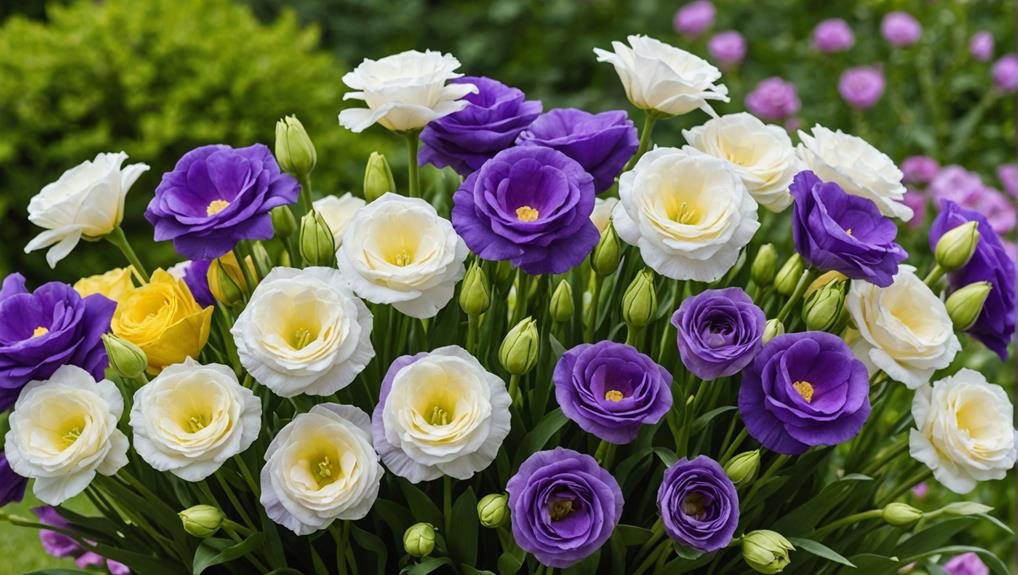
Building on the elegant physical characteristics of Lisianthus, the flowers are also celebrated for their extensive range of available color varieties, making them a versatile choice for wedding arrangements. This variety of Lisianthus includes hues that can cater to diverse wedding themes and personal preferences, enhancing the aesthetic appeal of any celebration.
Eustoma comes in a spectrum of colors, each carrying its symbolic meaning. The white flowers represent purity and innocence, making them a popular choice for traditional wedding ceremonies. Pink lisianthus exudes romance and admiration, ideal for adding a touch of tenderness and warmth. The availability of purple, blue, and peach shades further expands the creative possibilities for brides and event planners.
- White flowers: Symbolize purity and innocence, perfect for traditional weddings.
- Pink lisianthus: Represents romance and admiration, adding tenderness to the occasion.
- Purple, blue, and peach: Offer additional options to match various wedding themes.
This versatile color palette allows for customized bouquet designs, ensuring that each arrangement resonates with the emotions, style, and ambiance of the celebration. Eustoma's color diversity makes it a favored choice for weddings, events, and special occasions, where specific color schemes are paramount.
Latin Name and Taxonomy
How does the plant known commonly as Lisianthus find its place within the scientific community? The answer lies in its Latin name and taxonomy. Scientifically designated as Eustoma, this charming flower belongs to the Gentianaceae family. Eustoma is known by various names, such as Texas Bluebell and Prairie Gentian, which highlight its widespread appeal and versatility. Often featured in wedding arrangements due to its delicate, bell-shaped blossoms and vibrant color spectrum, Eustoma is a favorite among florists and brides alike.
| Common Name | Latin Name | Family |
|---|---|---|
| Lisianthus | Eustoma | Gentianaceae |
| Texas Bluebell | Eustoma | Gentianaceae |
| Prairie Gentian | Eustoma | Gentianaceae |
| Lizzy | Eustoma | Gentianaceae |
| Eustoma (Double) | Eustoma grandiflorum | Gentianaceae |
Eustoma's slightly succulent leaves and distinctive blooms make it a staple in wholesale flower markets, often sold in bunches of ten stems. The best quality stems reach 75-80cm in height, available in both double and single varieties. The plant's taxonomy and classification provide a framework that aids botanists, horticulturists, and florists in identifying and cultivating this exquisite species, ensuring that it continues to grace wedding ceremonies and other special occasions with its elegance.
Geographical Origins

Where does the elegant Lisianthus, scientifically known as Eustoma, find its roots geographically? This captivating flower traces its origins to the warm regions of North and South America. Specifically, Eustoma is native to the southern United States, Mexico, the Caribbean, and northern South America. These areas provide the ideal environment for this plant to flourish, characterized by sunny climates and well-draining soil.
In its native habitat, Eustoma thrives in grasslands and prairies, where the conditions align perfectly with its growth requirements.
The geographical origins of this flower are marked by:
- Warm regions: The southern United States, Mexico, the Caribbean, and northern South America.
- Sunny climates: Eustoma requires ample sunlight to grow robustly.
- Well-draining soil: Guarantees that the plant does not succumb to root rot and other moisture-related issues.
The natural proclivity of Eustoma for dry, sunny environments has influenced its successful cultivation in various countries worldwide. Understanding its geographical origins helps growers and florists replicate these conditions to produce the highest quality blooms. This knowledge is essential for anyone looking to incorporate Lisianthus into their floral designs, ensuring that the flowers maintain their beauty and vitality.
Season Availability
Eustoma flowers, valued for their delicate beauty and versatility, are accessible all year round, making them a perfect choice for any season. Their year-round accessibility guarantees that they can enhance weddings and events regardless of the season, offering a consistent touch of grace and allure. This makes Eustoma a dependable choice for floral arrangements, fitting for both spring weddings and winter celebrations.
The lasting beauty of Eustoma flowers allows them to effectively convey emotions and sentiments in any season. Their capacity to thrive in warm, arid climates further boosts their appeal, ensuring their availability whenever required. Below is a table illustrating the seasonal presence of Eustoma flowers to visualize their year-round existence:
| Season | Availability |
|---|---|
| Spring | Year-round |
| Summer | Year-round |
| Autumn | Year-round |
| Winter | Year-round |
| All Seasons | Consistent and Reliable |
Their steady availability and graceful appearance make Eustoma flowers an outstanding option for anyone seeking to infuse a touch of elegance into their event. Whether it's a garden wedding in the spring or a winter celebration, Eustoma's timeless beauty remains a reliable choice for floral embellishments.
Growing Conditions
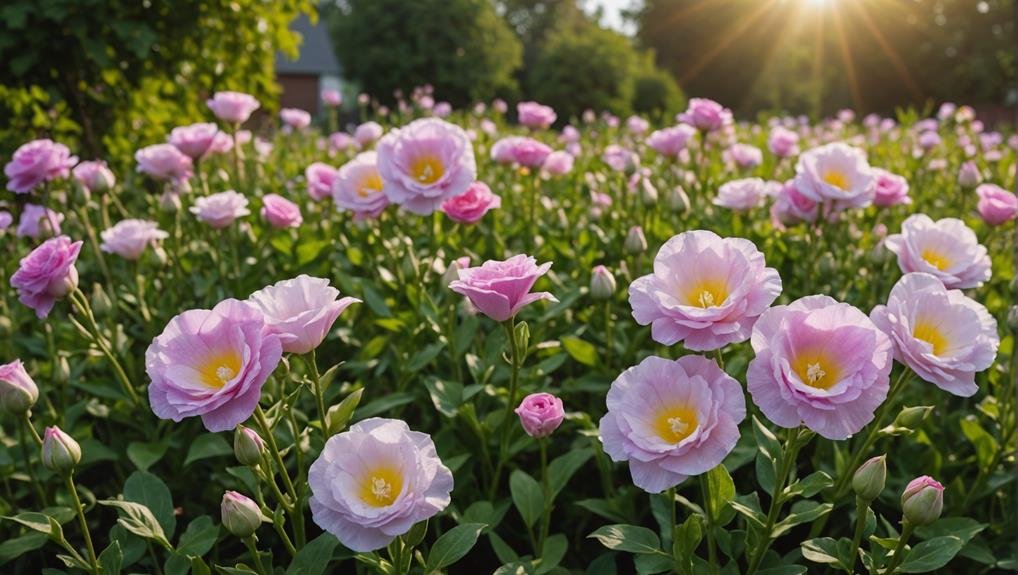
To cultivate Eustoma successfully, it is imperative to provide full sun exposure for 6-8 hours daily in well-draining soil with a balanced pH. This foundational requirement supports the plant's growth, making it an excellent choice for wedding flowers.
Eustoma, often celebrated as the perfect wedding flower, thrives in warm, dry climates. Ensuring consistent moisture in the soil is essential, but it is equally important to avoid overwatering or underwatering.
Eustoma benefits from a flower fertilizer high in potassium, which promotes robust blooms ideal for sophisticated flower arrangements. Avoiding high humidity is also pivotal, as it can hinder the plant's growth and longevity.
Regularly changing water every 2 days and trimming stems can optimize absorption, ensuring the flowers remain fresh and vibrant for wedding displays.
- Sunlight: 6-8 hours of full sun exposure daily.
- Soil: Well-draining with a balanced pH.
- Climate: Warm and dry, avoiding high humidity.
Cultural Significance
As a symbol of peace, purity, admiration, and everlasting love, Eustoma holds significant cultural relevance. This flower's elegant appearance and deep-rooted symbolism make it an ideal choice for various ceremonial and celebratory occasions, including weddings.
The cultural significance of Eustoma is notable; it effortlessly conveys emotions such as love, joy, and appreciation, adding a layer of sophistication to any event.
Eustoma's elegance is timeless, transcending seasonal boundaries and offering consistent warmth, joy, and beauty. Its versatility and enduring appeal make it a popular choice not only for weddings but also for other events and tributes.
The flower's ability to symbolize peace and purity aligns seamlessly with the sentiments of admiration and everlasting love, making it a meaningful addition to any ceremonial setting.
In many cultures, Eustoma is cherished for its ability to convey deep emotional messages through its delicate petals and refined structure. Its symbolism resonates with year-round sentiments, ensuring that the flower remains a beloved choice for those seeking to express profound emotions elegantly.
The cultural significance of Eustoma thereby enhances its appeal, solidifying its status as a timeless and versatile floral choice.
Typical Use in Weddings
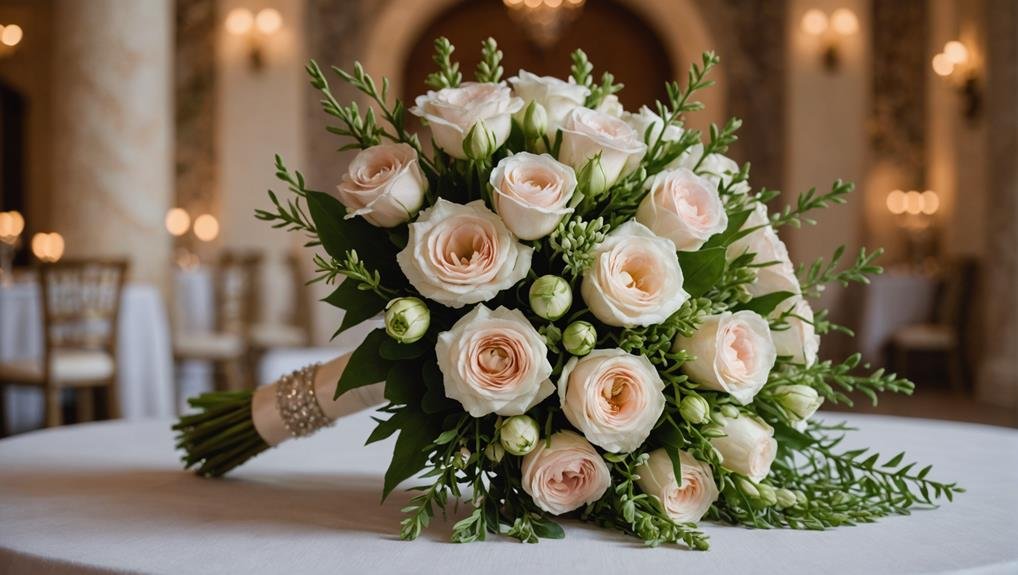
In wedding ceremonies, the use of Eustoma flowers extends to bouquets, centerpieces, boutonnieres, and corsages, contributing to the overall elegance and sophistication of the event. This versatile flower, with its delicate petals and wide range of colors, is a popular wedding choice due to its symbolic meanings of peace, purity, admiration, and everlasting love.
Expert tips highlight the importance of Eustoma in creating a beautiful wedding ambiance, as it can seamlessly integrate into various thematic settings. Eustoma arrangements can be customized to reflect the couple's style, theme, and emotional sentiments, making it an ideal choice for those looking to add a touch of personalized charm to their special day.
For couples seeking professional guidance, Floristique offers a wide range of Eustoma creations tailored for weddings, ensuring that each floral arrangement enhances the overall aesthetic and sentiment of the occasion.
- Bouquets: Eustoma flowers are often chosen for bridal and bridesmaid bouquets, adding a soft, romantic feel.
- Centerpieces: These flowers make stunning centerpieces, blending effortlessly with other floral elements.
- Boutonnieres and Corsages: Eustoma is also used in boutonnieres and corsages, providing a cohesive look across the wedding party.
Alternative Flower Types
When selecting wedding flowers, numerous alternative types such as roses, peonies, dahlias, and hydrangeas provide an array of aesthetic and symbolic options. Each of these flowers offers unique characteristics that can enhance the overall wedding theme with their diverse colors, fragrances, and shapes.
Roses are a classic and versatile choice, symbolizing love and romance. Available in various colors and sizes, roses can be incorporated into any wedding style, from traditional to contemporary. Their timeless appeal makes them a favorite for bridal bouquets and centerpieces.
Peonies, known for their lush and fragrant blooms, symbolize prosperity, good fortune, and a happy marriage. These flowers are ideal for adding a touch of elegance and luxury to wedding arrangements. Their voluminous petals and soft hues make them a popular choice for spring and early summer weddings.
Dahlias offer a wide range of colors and intricate bloom shapes, making them a striking addition to any floral arrangement. Their vibrant and bold appearance can create stunning visual impact, suitable for both rustic and modern wedding themes.
Hydrangeas, with their voluminous clusters of blooms, provide texture and fullness to bouquets and decorations. Available in various shades, from soft pastels to deep blues, they can complement any wedding color scheme.
